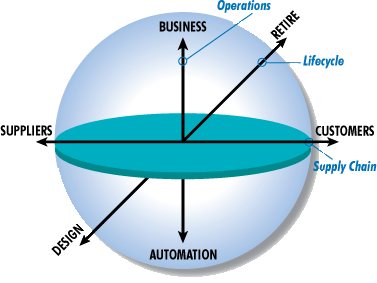In order to think through what it means to be a Real-time Enterprise, it helps to have a robust model of the manufacturing enterprise. ARC introduced the Collaborative Management model for this reason, and it has gained broad acceptance.
What Is Collaborative Management Model (CMM)?
 Collaborative Management Model (CMM) provides a means for thinking about all of the complex interactions, applications, collaborations, and processes that an enterprise entails. ARC is unique in depicting the globe and three intersecting axes which are the heart of the CMM Model. CMM also positions an enterprise's plants and facilities as nodes in a value network.
Collaborative Management Model (CMM) provides a means for thinking about all of the complex interactions, applications, collaborations, and processes that an enterprise entails. ARC is unique in depicting the globe and three intersecting axes which are the heart of the CMM Model. CMM also positions an enterprise's plants and facilities as nodes in a value network.
CMM is the framework for organizing and controlling the key business processes of an enterprise. Business leaders use it to drive strategic planning and technology assessment. It maps existing conditions and a migration path for improvements. Users also identify new ways of leveraging web-based technologies and partners to compete. They achieve a common perspective for the selection and integration of technologies among manufacturing operations, IT, business planning, plant systems, and others. In other words, it aligns your manufacturing IT investments with your business strategy.
How Are You Affected?
ARC has found through customer visits, user surveys, and supplier interviews that nearly all companies are struggling with these questions:
- How can we leverage our existing technology to realize real measurable cost savings?
- Where can we get the best ROI when implementing new technologies?
- How do I get the broader team aligned as an agent for significant positive change?
Today, opportunities for improving operations are often found between business functions. After mapping your applications with the model, opportunities are more easily identified, communicated, and acted upon. With ARC's CMM, you gain a clearer perspective for determining architecture, technology, applications, business processes, integration needs, user benefits, and return on investment (ROI). It helps you justify your project plan and capital budget.
CMM integration projects that improve business performance have been identified and are being implemented now. Companies are dramatically enhancing their operations and their extended supply chain. The next wave of business improvement is upon us. According to Greg Gorbach, ARC's VP for Collaborative Enterprise Management, "Companies need an enterprise-wide focal point for managing critical processes, services, and security. This is a driver for the Service Based Architecture."
What Are the Benefits of Collaborative Management Model (CMM)?
How Can ARC Help?
ARC's analysts can drill down into the areas of the CMM that interest you. In this example, the bottom half of the CMM model is exposed in more detail through the graphic for a Collaborative Automation System. Even more specifics are available to help define your strategy for either discrete, hybrid, or process automation systems.
The CMM model provides a starting point for your team to define your company's specific strategy and build consensus. The result is a credible plan with clear business benefits that will gain management's support.
